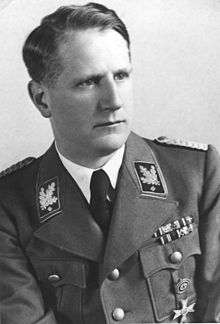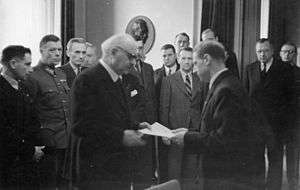Leonardo Conti
Leonardo Conti, MD (German pronunciation: [ˈleːonaɐ̯doː ˈkɔntiː]; 24 August 1900 in Lugano – 6 October 1945 in Nuremberg) was the Reich Health Leader in Nazi Germany. The killing of many Germans who were of "unsound mind" is attributed to his leadership.[1]
Leonardo Conti | |
|---|---|
 SS-Gruppenführer Dr Conti | |
| Reich Health Leader | |
| In office 1939 – August 1944 | |
| Deputy | Kurt Blome |
| Preceded by | Gerhard Wagner |
| Succeeded by | Office abolished |
| Personal details | |
| Born | 24 August 1900 Lugano, Switzerland |
| Died | 6 October 1945 (aged 45) Nuremberg, Bavaria, Allied-occupied Germany |
| Cause of death | Suicide by hanging |
| Signature | |
| Military service | |
| Allegiance | |
| Branch/service | |
| Rank | SS-Obergruppenführer |
Early life
Conti was born to a Swiss Italian father, Silvio, and a German mother, Nanna Pauli; his mother later became the Reich Midwifery Leader in Nazi Germany. Conti later studied medicine at the Humboldt University of Berlin) and the University of Erlangen–Nuremberg. He became active in the völkisch movement and the Viking League, and co-founded an antisemitic paper called Kampfbund ("Struggle league"). He took part in the Kapp Putsch in 1920. From 1923 he was a member of the Sturmabteilung (SA), becoming their first physician; one of his patients was Horst Wessel, who eventually became a martyr of the Nazi Party. In 1925, he promoted "Über Weichteilplastik im Gesicht", a book about facial plastic surgery. In 1927 he left his usual activities and started organizing the National Socialist German Doctors' League.
Nazi doctor
He joined the SS and, as an "old fighter" of the party, he was appointed by Hermann Göring to the Prussian State Council. Conti held the posts and titles of Head of the Reich Physicians' Chamber (Reichsärztekammer), Leader of the NSDÄB, and Leader of the Main Office for the People's Health. In 1937 he was elected to the presidency of the FIMS, the International Federation of Sports Medicine.[2] The FIMS today considers this to have been "a black page' in their history. In 1939, Conti was appointed Reich Health Leader and State Secretary in the Interior Ministry. On 1 July 1941, as the Chief of Health in the Reich, he obtained the classification of Pervitin (see History and culture of substituted amphetamines) among the products defined by Reich law on opiates. It condemns the private use of Pervitin, but does not call into question its use for military purposes.[3] In 1944, he was promoted to SS-Obergruppenführer (lieutenant general).
Action T4
Leonardo Conti was a staunch promoter of a public medical administration strongly controlled by the Nazi state. Under his leadership, local health offices were further expanded to allow for a genetic control and selection of the population in order to remove "weak" elements for the improvement of the German race, a doctrine known as eugenics. The various programmes were the basis for "racial hygiene" a lethal part of the Nazi philosophy.
Accordingly, he was co-responsible for the forced sterilization program, the racially motivated forced pregnancy interruptions, and ultimately the Action T4 program.[4] It is also undisputed that Conti participated in human experiments.[4]
The Nazi involuntary euthanasia program involved the planned murder of mentally and physically impaired patients and started in September 1939 when the policy was approved by Hitler in a personal decree. He approved the euthanasia of a young disabled boy, Gerhard Kretschmar, at the request of his father, but approval was quickly extended to other disabled children, and then disabled adults. The approval of three doctors was needed for killing of any individual to proceed. The killings were conducted in many hospitals and asylums such as Hadamar Euthanasia Centre by a variety of methods, including enforced starvation, injection of lethal drugs, and gassing using carbon monoxide. Patients were carefully deceived to believe that they were simply taking a shower so as to entice them into the gas chamber, then locked in and asphyxiated through carbon monoxide poisoning. Although public protests led by Bishop Galen and others forced the policy to be officially suspended in 1941, it continued unofficially until the end of the war.

The program constituted the basis for the later programme of mass murder known as the Holocaust of Jews, Poles, Gypsies as well as other Slavs, and Russian POWs in camps such as Treblinka, Sobibor, Belzec, Chelmno, Auschwitz-Birkenau, and Majdanek. Gassing with Zyklon B was used mainly at Auschwitz and Majdanek with over 1 million victims, and Carbon monoxide at Treblinka, Sobibor, Belzec and Chelmno, the main extermination camps. Such mass murder followed the earlier murders through gunfire by the Einsatzgruppen death squads. Many of the SS staff involved in the later murders developed their lethal methods during the Action T4 programme, overseen by Conti. Victims were deceived in the same way as in Action T4, using very elaborate means to convince them that no harm was intended to them.
Conti was also involved in the forensic investigation into the Katyn massacre, and received a detailed report, known as the Katyn Commission on the discovery from an international team of experts.
Death
On 19 May 1945, after Germany's surrender, Conti was imprisoned and would have been brought to the Doctors' Trial for his involvement in Action T4. However, on 6 October 1945, over a year before the trial began, Conti hanged himself in his Nuremberg cell.[5]
See also
- List SS-Obergruppenführer
References
- Snyder, Louis L. (1976). Encyclopedia of the Third Reich. McGraw-Hill. ISBN 9780709157175.
- "Our History". International Federation of Sports Medicine (FIMS).
- La Pilule de Göring. La fabuleuse histoire de la pervitine on YouTube (in French).
- Leyh, Ernst-Alfred (2002) Leonardo Conti and the "ideologization of medicine during the Nazi dictatorship" (abstract). Universitätsbibliothek Heidelberg (in German).
- Wistrich, Robert S. (4 July 2013). Who's Who in Nazi Germany. Routledge. pp. 31–2. ISBN 978-1-136-41388-9.
External links

- Biography of Leonardo Conti
- Leonardo Conti in the German National Library catalogue (in German).
- Newspaper clippings about Leonardo Conti in the 20th Century Press Archives of the ZBW